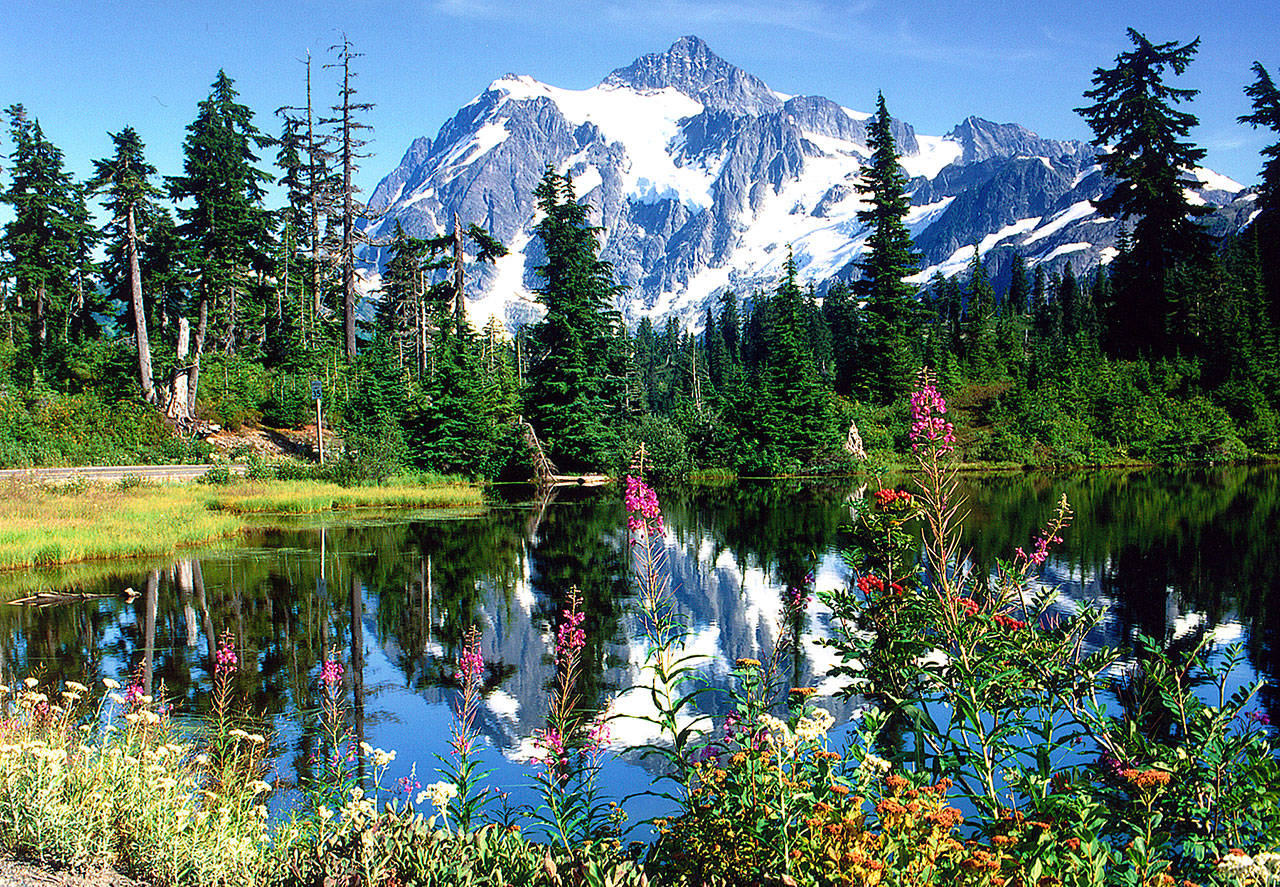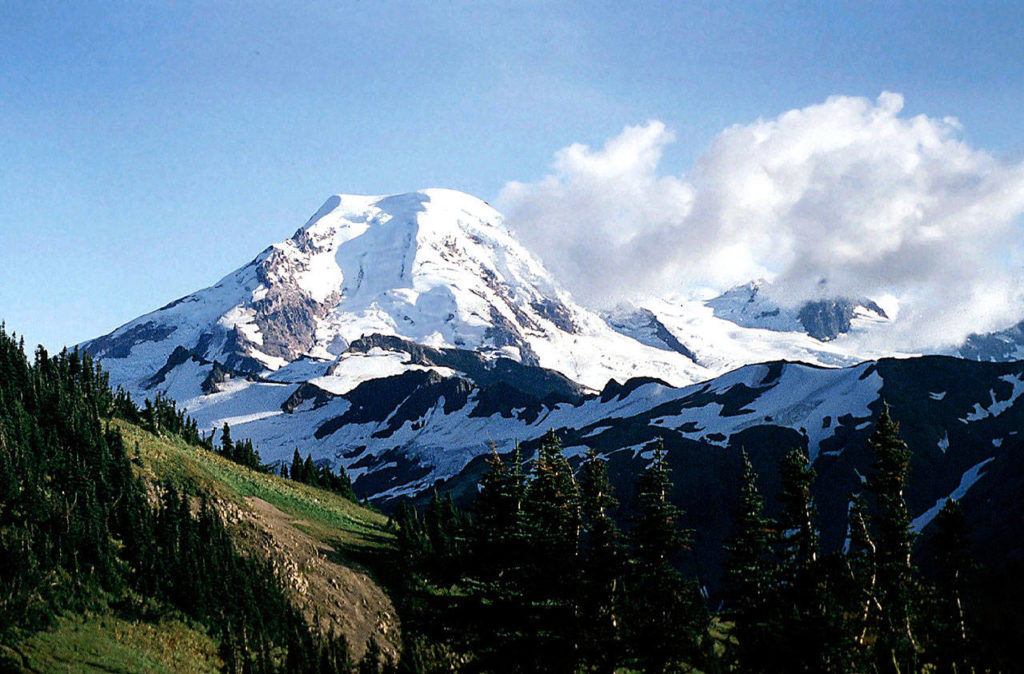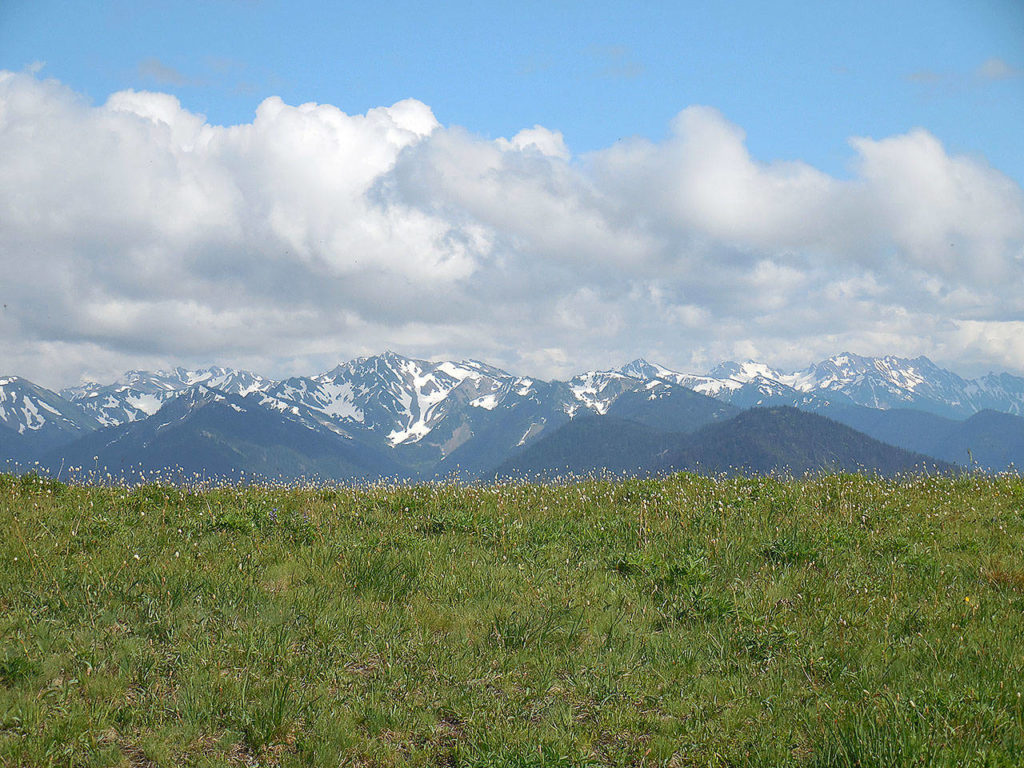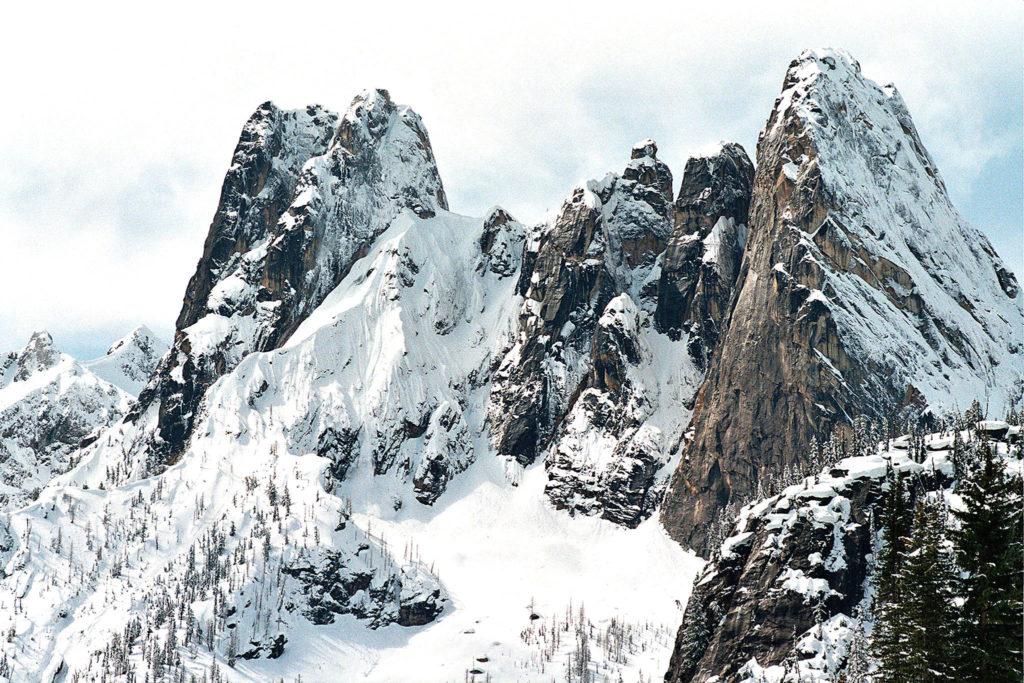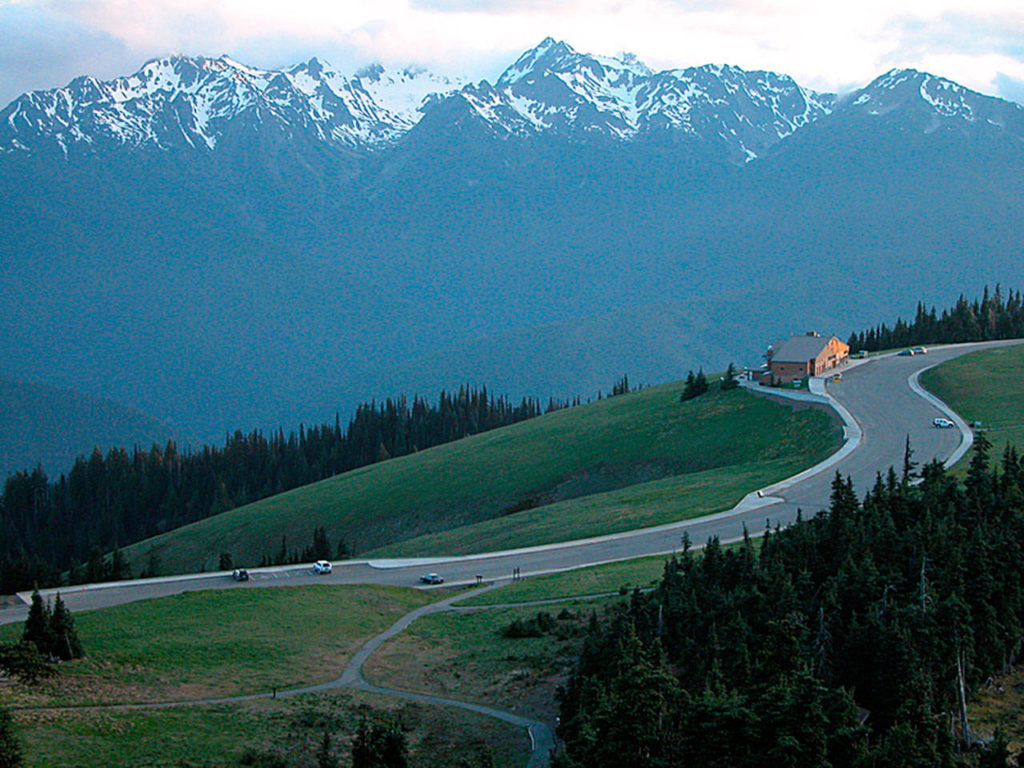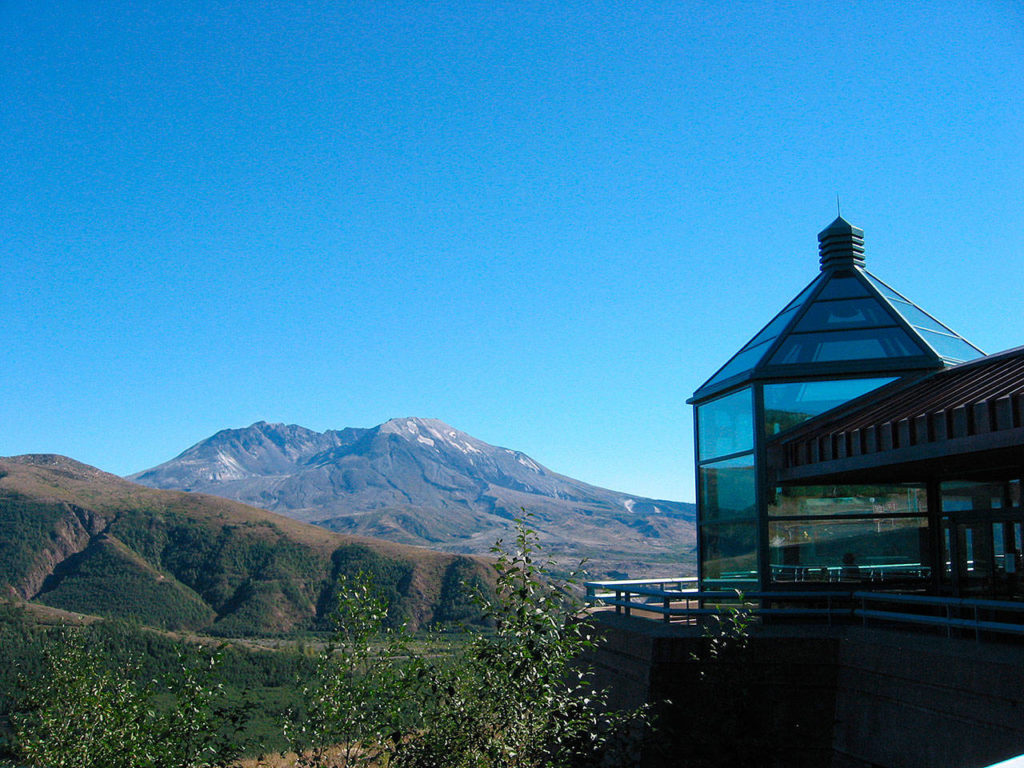From a distance, the mountains of the Cascade and the Olympic ranges look formidable and inaccessible. The jagged peaks have been compared to bared teeth, spikes and a picket fence.
At higher elevations, they’re dotted with glaciers and streaked with avalanche runs. The Cascades’ volcanoes are dormant or quiet, but every now and then a puff of steam from Mount Baker or Mount St. Helens reminds us of the possibilities.
Take advantage of the last weeks of summer and visit or admire a mountain before the snow flies.
Mount Shuksan. This picturesque peak is 9,127 feet above sea level. Just 11½ miles from the Canadian border and immediately east of Mount Baker (10,781 feet, holds the world record for snowfall), the blocky Shuksan sits like a sumo wrestler.
Drive State Route 542 to the end, at more than 5,000 feet elevation. The photo opportunities start as soon as you exit of the car, with the close-by Picture Lake and Shuksan in the distance making an ideal couple.
The trail to Artist Point has been cleared, hence the several feet of snow alongside, allowing foot traffic to reach spectacular views.
Artist Point offers 360-degree views of mountains that includes Shuksan and Mount Baker (second largest glacier system in the Lower 48), views that draw high numbers of visitors. Show up early to avoid the crowd.
The easy 1.2-mile round trip only gains 200 feet in elevation. If there’s time, go another half-mile along a ridge leading to Huntoon Point, with more grand views. If you go in September, call 360-599-2724 to check snow conditions.
Hurricane Ridge. Olympic National Park’s Mount Olympus (7,965 feet) is the main summit seen from here, dotted with eight glaciers and surrounded by other peaks. For an easy to moderate walk, drive 1½ miles past the visitor center and walk the 1½-mile mostly paved trail to Hurricane Hill for grand views.
Don’t feed the wildlife, and for your own safety, stay away from the unpredictable mountain goats.
Mount Constitution. Drive right to the highest point in the San Juan Islands in Moran State Park on Orcas Island: Mount Constitution stands at 2,410 feet.
The road up is one switchback after another (beware of bikers). The reward is a panoramic view of islands, mountains and into Canada. Climb the stone tower that was built by the Civilian Conservation Corps in 1936.
The CCC also built the road and bridges to the summit. The site usually draws a crowd, especially on summer weekends, but go early for the sunrise and quiet.
Mount St. Helens. At 4,314 feet above sea level, Johnston Ridge Observatory is 5½ miles away. You’ll pass several other visitor centers but Johnston has the best view of the 1980 blast zone, crater, lava dome and pumice plain. Allow plenty of time to see the exhibits and learn about volcano monitoring.
Climbing the volcano (8,365 feet) is another story. Permits are required, and quotas are in place spring through fall. Go to http://mountsthelens.com/hiking for more information.
Mount Rainier. This icon is the most accessible glaciated peak in North America. Mount Rainier is at 14,410 feet elevation.
Drive to the Paradise Visitor Center (5,400 feet), enjoy the exhibits and then pick a trail. There are several short and easy, moderate and extremely difficult (Camp Muir) routes. The Nisqually Vista is only a 0.3-mile walk to see the Nisqually glacier’s descent from the summit.
My favorite is the Skyline Trail, a 5.3-mile loop that gains 1,700 feet. There are, weather willing, good views of the top of the mountain, as well as Mount St. Helens, Mount Adams, Mount Hood and others.
Washington Pass Overlook. A short, wheelchair-accessible paved trail at 5,455 feet elevation leads to terrific views of Liberty Bell Mountain rising out of the forest with other peaks, including Kangaroo Ridge. A steel railing keeps visitors away from the edge, where there is a 700-foot drop to Highway 20.
For an easy hike, take the nearby 4.4-mile round-trip Blue Lake Trail, less than a mile west of the pass. Have lunch at the lake and enjoy the Early Winters Spires. See the crack that led to the name of Liberty Bell Mountain.
Slate Peak. I have to remind myself that I’ll love the view because by the time I get there, my fingers have to be peeled off the wheel. The last 12 miles on the road from Mazama is unpaved, exceedingly narrow, hugs a drop-off, often harrowing. Do not take an RV.
The reward is the highest point in Washington (7,440 feet elevation) that can be reached by a vehicle, a flattened peak that has an old fire lookout tower, views of dozens of peaks in the U.S. and Canada, and the sight of old mining scars on the land.
Timing is important. Roadwork on Hart’s Pass Road near Mazama is blocking access until mid-September. If the snow hasn’t started, go then. If not, wait until next summer.
Some of the destinations in this story require a state Discover Pass, a federal America the Beautiful Pass, a Northwest Forest Pass or, in the case of national monuments, often a separate entrance fee.
Parks pass fees for seniors to go up
The current $10 lifetime senior federal passes for national parks and several other agencies is being increased to $80 (plus a $10 processing fee) on Aug. 28 when the new America the Beautiful lifetime pass will be available. It’s the first price increase since 1994.
The senior pass now will be the same price as an annual America the Beautiful pass. The new annual senior passes will cost $20.
Currently held lifetime senior passes will remain valid, and any order must be postmarked before Aug. 28 to get the pass for $10 (http://store.usgs.gov/senior-pass). A senior’s traveling companions may enter for free.
Access to the majority of the 417 National Park Service sites remains free.
Columnist Sharon Wootton can be reached at 360-468-3964 or songandword@rockisland.com.
Talk to us
> Give us your news tips.
> Send us a letter to the editor.
> More Herald contact information.
